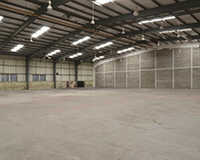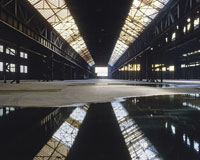 Dracula Untold opened in cinemas worldwide late last month. The Vlad the Impaler-inspired romp quickly grossed around $150m (£94m) thanks to big sales in Russia, among other places, racing ahead of its $70m production costs.
Dracula Untold opened in cinemas worldwide late last month. The Vlad the Impaler-inspired romp quickly grossed around $150m (£94m) thanks to big sales in Russia, among other places, racing ahead of its $70m production costs.
Audiences may have thought the big attraction was actor Luke Evans. But EG can now reveal that the star of the show was a warehouse in Belfast.
The former Cantrell & Cochrane drinks factory at Castlereagh Road was the location for the horror flick, one of a growing army of warehouse property starlets making headway in the film business.
The 124,706 sq ft property is close to Belfast’s Titanic Studios, itself home to HBO’s wildly popular Game of Thrones. It was rented to Universal Pictures in summer 2013. Colliers International subsequently sold the property to unnamed buyers for £3.3m.
It is hard to be certain how much industrial floor space is now being used as improvised studio and production units, but the figure is thought to be large. One London location-scouting agency estimates it amounts to about 25% of its business, up from a very modest figure five years ago.
Warehouses are claiming a large proportion of the 18,000-plus filming days a year in London. And although the Liverpool Film Office declined to say how many of the 170 productions filming in Liverpool so far this year used warehouses, observers insist it is considerable.
Why the sudden interest in warehouses? Industry experts say that, in part, it is because the UK film business is booming thanks to generous tax reliefs. More UK film production means demand for more UK locations. But warehouses also owe some of their popularity to the latest media aesthetic that favours big, open, blank spaces with a grungy vibe.
Lex Wade is head of locations as Soho-based location management agency Salt. “We’ve seen a huge increase in demand for warehouses from 30,000 sq ft upwards, not just for older character properties but larger units for use as production bases. A modern warehouse is a blank canvas that a production crew can take for a week for a TV advertisement, or for years for a regular TV series,” he says.
Locations within the M25 are preferred he says, north and west London along the M4 and M40 corridors are particularly favoured.
“Production companies like modern warehouses because they are very secure, and located away from rivals and from prying eyes. They also like the high eaves – anything over 30ft is good for the lighting rigs – plus warehouses have goods yards and vehicle access, three-phase power for the lights and equipment, and clean running water. Basically, warehouses are good-to-go as production bases,” Wade explains.
Vida Scannell at South West London-based Dixcot Locations says warehouses also appeal to directors’ sense of modern aesthetics.
“Big spaces, high ceilings, white look, industrial feeling – it’s hard and urban,” she says.
“If you have the right premises you can make a living from being a film location. Obviously some jobs pay better than others – an online catalogue stills shoot isn’t going to earn you as much as a TV commercial – and much of the location work isn’t glamorous. But that doesn’t mean it can’t get glamorous,” she says.
Southwark’s Nutbrook Studios, SE15, are a good case in point. The 15,000 sq ft complex is mostly studio space for artists – sculptors, painters and so on – but around 4,500 sq ft of standard warehousing floorspace has been made available for filming.
Guy Forrester, partner at Nutbrook Studios, explains: “We bought the building in 2011 as light industrial space. It cost a lot to convert most of the space for artists, so we left a chunk as flexible space. It was once a printing works so it has a laser-level floor and massive electrical capacity, so is ideal for film production.”
“We were novices at the film business, but have been incredibly popular of late. I suppose it was 10 or more shoots a year, earning about £20,000 a year or more on average.”
That equates to around £4.50 a sq ft. Worth it? Many landlords think it is (see box), although Forrester has his doubts.
He says: “Some of the shoots involved more servicing by us than others. And when one of our artist tenants said he wanted a big space for a big project, we rented him the whole space on an 18-month short-term lease. The equivalent for us of 20-30 location shoots.”
All the glamour of Hollywood, and an income? Forrester says the film business can be a good warehouse option.
“I viewed the film location issue as a meanwhile use, but the film world is a small one and word quickly got around,” he says. “I would certainly recommend it to other landlords.”
Warehouses paved with gold?
Landlords can make a healthy return by renting premises as short-term production bases or as locations.
However, the fee depends not on the size of the building, but on the size of the film project. A big-budget TV commercial might pay £1,000 a day for as long as three weeks; a low-budget editorial photoshoot just a few hundred in total.
“If you are the location for a successful TV series the income can be good. There’s a site in the east of London that’s seen filming continuously for five years. By now the production company will be looking for good value – so it’ll be a few hundred pounds a day – but that still adds up,” says Salt’s Lex Wade.
Registering with a location agency – or via Creative England, the UK film industry body – is usually free of charge. Agencies charge 20% commission on rental income, for which they find clients and sort out legal and insurance issues.
The Bill or the bill?
Renting out warehouses for temporary studio use is one thing – owning or investing in a studio complex is quite another.
So says Simon Peters, finance director at Panther Securities, and landlord of the 220,000 sq ft studio complex in Wimbledon which once housed TV cop drama The Bill.
Panther are entrepreneurial landlords and were happy to take a 25% stake in the production company. But Wimbledon Studios Ltd fell into administration this summer. A new tenant – believed to be Marjan Television Network – has now been signed up on a 15-year lease at £1.5m a year. Two and a half years’ rent has been paid in advance.
The warehouse’s long tenure as home of The Bill was a mixed blessing, says Peters.
“The sets – a police station, a street scene which still looks nice – were popular to start with, but people soon get bored with them. I guess blank boxes pay better as film locations.”
The cost of converting the premises from fixed sets to flexible space was part of what prompted the appointment of administrators KPMG.
Peters explains: “The London film business is said to be doing well, and we had a few interesting enquiries, but not so many, because London rents are relatively high.”
High capital costs, complex leasing arrangements for production equipment and the sometimes here-today-gone-tomorrow nature of film and TV projects, all make for instability.
Peters advises landlords to think carefully. He warns: “We’ve not considered going down the route of temporary use for filming, although I know some large landlords do it, and every portfolio is carrying vacant space, so it’s appealing.
“But if you convert a warehouse for studio use 100% of the time, you have to weigh up the benefits. We had plenty of advantages at Wimbledon and still found it difficult to make it pay.”











